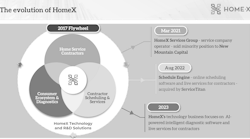by Mark Eatherton
John Siegenthaler has brought a whole new perspective of the engineering world to hydronic heating. He brings an insider's look and interprets those engineering terms on a level that is easily understood by the typical field installer. He also de-mystifies the engineering principles that have long been written off as too complicated to follow by the common man.
His new book, "Modern Hydronic Heating For Residential and light Commercial Buildings, 2nd Edition," is available through the Radiant Panel Association (RPA) Bookstore at www.radiantpanelassociation.org. The 575-page book costs $98.95, plus shipping.
When John introduced "Modern Hydronic Heating For Residential and Light Commercial Buildings, 1st Edition," I immediately bought the book and immersed myself in his world. I found many of the explanations to be crisp and understandable. I dabbled in the mathematical sciences that John provides to give a more detailed look at the overall picture of the mechanics behind hydronics.
I adopted the first edition as the main textbook that I use in two courses that I teach at Red Rocks Community College in Denver. The fall course is Basic Hydronic Heating, and it covers all aspects of hydronic systems including boiler and component selection and component location. The spring class is Advanced Hydronic Radiant Heating, which covers all aspects of radiant heating systems, except the basics covered in the fall.
I met John Siegenthaler about 10 years ago at a seminar he was teaching for a boiler manufacturer. We usually see each other at least once a year at RPA events where he and I teach different classes.
When John told me he was getting ready to introduce the second edition of his book, I knew that it was destined to become an industry standard. The first one had already succeeded in becoming an industry-recognized standard, and this edition is even better than the first.
It’s full of new drawings, photographs, and schematics that reflect advances in industry standards and technology since the first edition was published nearly 10 years ago, and it’s tempered by John's personal experiences. It has been expanded to include information pertaining to "state-of-the-art" heat sources, including modulating/ condensing boilers, all the different types of solar systems, ground source heat pumps, and a new section on wood-burning boilers. He's included drawings showing multiple fuel source boilers and how they're interfaced into the system using primary secondary piping considerations.
The new version is less of the mathematician and more of the practical Siggy we've come to love. For those of you algebra fans with the scientific calculators, it still has plenty of formulas for your indulgence and edification.
As with the first version, each chapter has a Questions and Exercise section. It also includes boldface Key Term words throughout the text, with a summary and complete list of Key Terms used in the preceding chapter.
At the back of the book is an expanded version of his original air removal section that includes purging and filling, as well as new information for troubleshooting air problems on the fluid side of these systems.
The new text is 125-pages longer than the first edition, with lots of useful information for the typical hydronic technician to wrap his arms around.
As a bonus, each copy has an academic version of Siegenthaler's Hydronic Design Studio Professional Version included in a CD-ROM. This is a "light" version of the software, a necessity for anyone designing, installing, and servicing light commercial and residential hydronic heating systems. It allows you to design your own "what if" scenarios and allows you to switch critical components in the system at the blink of an eye to see what the net result will be.
Although the academic version is limited in capacity, it’s adequate to help work out the problems given at the back of each chapter. It will also make you want to run out and buy the full-blown copy of the software at your earliest convenience.
This book is a must have if you are in the hydronic heating/cooling business. n
Mark Eatherton is a Denver-based contractor who writes a monthly hydronics column for CONTRACTOR magazine. He can be reached via e-mail at [email protected] or by phone at 303/778-7772.










